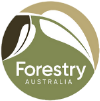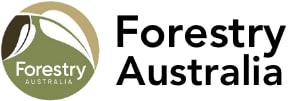
Pruned Stand Certification
Content for the PSC program is currently being reviewed and updated.
Pruned Stand Certification (PSC) provides growers with an assessment and certification system that quantifies the quality of pruned logs in a stand, so that a premium payment can be received for the high value logs. The system is managed throughout Australia by Forestry Australia.
What is the PSC service?
NZ Forest Research Institute (FRI) initiated and implemented the service after considerable consultation with private forest growers, large forest-growing companies, forestry consultants, Ministry of Forestry research and management staff, millers, and forestry sector organizations. Forestry Australia has adapted the system for Australia.
The Pruned Stand Certification service provides:
1. A set of standards and procedures in a 30 page manual describing:
- necessary pruning quality
- tree measurements
- land description classification
- auditing, i.e., verification of data collection standards.
2. Overall administration by Forestry Australia.
3. Data processing, mapping and document preparation, and long-term data storage, all carried out by AFG.
4. A nationwide network of auditors, recognized by AFG, who are prepared to visit any stand soon after pruning and carry out the essential data and map verification task.
The stand assessment procedures were developed after considerable research. Their aim is to determine the benefit in stand quality resulting from each pruning lift; they must do this accurately, and be time- and cost-efficient in application yet easily understood and applied by the layperson.
The PSC service is recognized and supported by most of the main forestry sector organizations. It is endorsed in principle by the following:
New Zealand Timber Industry Federation, representing sawmillers, timber processors and merchants;
- NZ Farm Forestry Association;
- NZ Forest Owners’ Association Inc.;
- NZ Institute of Forestry Inc.;
- Ministry of Forestry;
- Tasman Forestry Ltd;
- NZFP Forests LTD;
- Forestry Corporation of NZ LTD;
The PSC service is endorsed in Australia by:
- Forestry Australia;
- National Association of Forest Industries
- Association of Consulting Foresters of Australia (ACFA)
- Private Forests Tasmania (PFT);
- TFGA-FARMWOOD, representing Tasmanian treegrowers co-operatives.
Buyers and sellers can see the logs from quite different points of view
- The mean diameter over pruned branch stubs (DOS) for each lift is only a couple of hand widths across (or so memory suggests);
- These pruned logs are inherently worth 2.5 times as much as unpruned logs. Therefore, for this particular stand, at current prices, an additional $12.000/hectare stumpage is anticipated because of the pruning.
- All pruned logs look the same;
- The best pruned logs can produce up to 80% of sawn outturn in clears grades while the worst produce no clears
- Qualities of pruned logs from small forest stands can vary widely, reflecting the growers’ knowledge, attitudes, and physical and financial ability to get the pruning done on time;
- A sample of logs from the accessible part of the stand may be quite different from what’s further in, perhaps because a single pruning lift took several years to complete;
- Any premium paid for the pruned material is at risk and may be lost.
The future scenario might be even worse than this. With pruned log supply potentially increasing over tenfold in the next decade, the main buyers of these logs could be off-shore, or at least very large companies.
There may not even be the opportunity for the sort of interaction illustrated on the front page, and premiums are unlikely to be paid where risk for the buyer is high. This very difficult situation can easily be avoided. The buyer really only needs to know a few very simple details, such as:
- How effective was the pruning? and
- Was all the stand treated the same way?
The grower can readily and cheaply provide these details by:
- Measuring a small but adequate sample of pruned trees to establish the DOS for each pruning lift;
- Assessing stem sweep in the pruned zone;
- Mapping the pruning boundary after each lift; and
- Having this information authenticated by an independent expert so that it is credible.
The Pruned Stand Certification (PSC) service has been introduced by Australian Forest Growers (AFG) to make this process possible.
How does it work?
Pruned Stand Certification can be applied to any species or any size or shape of stand or shelterbelt. Several small blocks can be considered as one stand if the effective pruning is the same. There is also a procedure for retrospective assessment if pruning has long since taken place. Once pruning has been carried out to a necessary minimum standard, the owner or owner’s agent (e.g., consultant, silviculture operator) can do the following:
- Provide land description information. This is found, for instance, on rate demands or survey plans.
- Locate and measure a minimum of eight five-tree plots. On each tree, measure pruning lift, diameter at breast height (dbh) and if pruning is over 4.5 metres, significant sweep if present. Stocking is determined either from stocking plots or from between-planted-row and between tree measurements. To make the task easier, DOS is measured on just two trees per plot and the dish measures are used to adjust the estimated DOS (i.e., double sampling, a valid scientific procedure).
- Provide maps showing pruning boundary, plot locations, relocatable reference points, scale, and grid or magnetic north. The title plan or an aerial photograph is usually adequate for mapping purposes.
The assessment work is carried out by someone who is not registered as a pruned stand certification auditor, then the stand must be visited by an auditor and have the pruning boundary and about 25% of all measurements checked for accuracy. If the auditor carries out the full assessment task, there is no need for further auditing.
Once accuracy constraints are satisfied, the auditor forwards the completed measurements and maps to AFG. AFG carries out the data processing and graphics work, issues the PSC certificate, and archives a photocopy of the certificate with the original data and maps. Certificates are uniquely numbered and the grower receives the only original. However, if the certificate is lost, a new one can be issued, and original data and maps can also be made available.
How much does it cost?
Forestry Australia currently charges for its services. The auditor will charge independently, and the amount will obviously depend on how much of the task is completed by the owner or owner’s agent. Even the provision of a ‘title plan’ map or aerial photograph and property legal description details will save the auditor considerable time and consequently cost to the owner. Charges by the auditor will vary depending on the many variables—travel distance, access, weed hindrance, quality of work and so on.
An example for a small farm plantation might be:
- The owner carries out all assessment and mapping work to the required standard, and the owner’s input is not considered in the cost; and
- The auditor checks map details and pruning quality, and re-measures two assessment plots. A total of 3 hours (including travel) is charged on each of the three pruning lift assessments.
Pruned stand certification charges are relatively independent of stand area, so doubling the pruned area, for instance, effectively halves the cost per unit area.
Based on New Zealand experience, the cost of pruned stand certification may range from $2/m3 to $6/m3 for pruned sawlogs.
However, a price list for pruned logs from one New Zealand region shows a range of $60/m3 based on log quality, and this range is supported by log sales in other regions. It is this premium that must be captured to justify the pruning cost, and the small additional investment in PSC will help achieve this. If the full assessment cost were accounted for, the PSC charge would be considerably higher but still quite small in comparison with both the pruning cost and the possible range in pruned log price.
How does the grower go about using the PSC service?
Either:
Have a registered auditor carry out the entire certification exercise. A list of auditors is available from Forestry Australia (click here) or from forestry offices. The provision of a title plan or an aerial photograph and land description details will save the consultant time and the grower money.
Or:
- Purchase the Forestry Australia manual with diameter tape from AFG. Also request a list of auditors.
- Carry out all mapping and assessment tasks as described in the manual.
- Contact an auditor and request an inspection.
Once all necessary standards are complied with, the auditor will forward maps and assessment data to Forestry Australia. Forestry Australia will return the certificate to the auditor who will forward it to the grower along with appropriate invoices.

